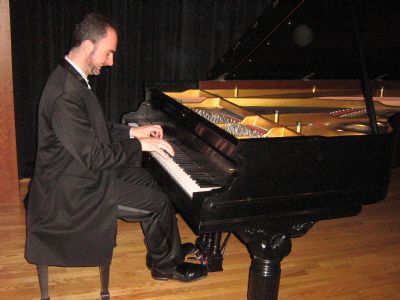|
Symphony
MYSTICAL PLANETS AND LIVELY GERSHWIN ORTIZ AT FINAL SRS CONCERT
by Peter Lert
Sunday, May 4, 2025
Symphony
VSO'S CONCERT MUSIC OF TIME, MUSIC OF PLACE
by Peter Lert
Sunday, April 27, 2025
Choral and Vocal
VOCAL ELEGANCE AND FIRE AT THE 222'S RECITAL APRIL 26
by Pamela Hicks Gailey
Saturday, April 26, 2025
CANTIAMO SONOMA SINGS AN INSPIRED GOOD FRIDAY MOZART REQUIEM CONCERT
by Pamela Hicks Gailey
Friday, April 18, 2025
DRAMATIC SHOSTAKOVICH SYMPHONY CLOSES PHILHARMONIC'S 25TH SEASON
by Terry McNeill
Sunday, April 13, 2025
LARGE COLLEGE OF MARIN AUDIENCE GREETS STOPHER ARTISTRY
by Terry McNeill
Saturday, April 5, 2025
Chamber
FRISSON DELIVERS SHIVERS OF DELIGHT
by Abby Wasserman
Sunday, March 30, 2025
OLD AND MOSTLY NEW IN SRS MARCH CONCERT IN WEILL
by Peter Lert
Saturday, March 22, 2025
Symphony
TWO FORMIDABLE SYMPHONIES AND PURPLE MOUNTAINS AT SRS CONCERT
by Peter Lert
Sunday, February 23, 2025
Chamber
THE PARKER CAPTURES DEMANDING ADES QUARTET AT RAC SEBASTOPOL CONCERT
by Peter Lert
Saturday, February 15, 2025
|
 |
 Russian Pianist Jura Margulis at the Henry F. Miller Concert Grand |
MARGULIS SUCCEEDS AGAINST LONG ODDS
by Terry McNeill
Tuesday, March 10, 2009
The odds for a successful piano recital didn’t look good. It was an unknown pianist from Russia via the University of Arkansas, playing for a new production company in the little-used small hall at the Schulz Museum in Santa Rosa — on a 110-year-old Henry Miller piano. Despite these long odds, Jura Margulis played an intriguing if not wholly satisfying concert on March 10 in front of 30 appreciative listeners.
Margulis played the opening Chopin Mazurkas (Ops. 30, Nos. 3 and 4) aggressively and with exceptionally strong contrasts. The first was a stately oberek (Polish dance), the second introspective. Prior to playing the majestical Polonaise in F Sharp, Op. 44, Margulis spoke at too much length about the pieces comprising the rest of the program, guaranteeing that much of his insightful prose would be lost when the actual performance arrived. Nonetheless, he offered a rhythmically strong and somewhat militaristic Polonaise performance, showing a fine octave technique with only a memory lapse to mar the drama.
One of Chopin’s most often played large works, the Op. 23 Ballade in G Minor, tells a story of considerable power, supposedly modeled on the writings of the Pole Adam Mickiewicz. All is familiar here, but Margulis brought new touches to the richly romantic score with a big ritard leading to the lyrical theme and many single notes held at the end of slow arpeggios. The playing had pesky fits and starts, an odd approach for a work with so much drama and momentum
Two Debussy works closed the first half, the radiant “Reflets dans l’eau” and the theatrical “L’isle Joyeuse.” The first of the 1905 Imagesfor Piano, “Reflets” was played with a big sound, the cascading arpeggios carrying over from the last two Chopin works. “L’Isle” was orchestrally conceived by Debussy and played that way by Margulis, lyrically but often bordering on the raucous, with a brittle treble tone, particularly when he wanted a lot of volume.
Liszt’s works occupied the second half, beginning with the popular D Flat Consolation, the third in a set of six from 1849. Margulis played with the phrases in this concise and poetic short work to the point where a glacial tempo almost stopped the musical line. There was pianistic color and harmonic emphasis throughout, and in the ethereal and slightly dissonant right-hand arpeggio near the end. For some reason, Margulis added a note after the two-note concluding chord.
It was brave to play the mighty B Minor Sonata on an unknown piano, but on balance the performance went well. Margulis began with staccato low Gs and swept into the maelstrom of notes with clean scales, a fast and even trill, and effective chord voicing in the chorale sections, introduced with extra-long fermatas. The octave technique was at all times admirable. This was not a performance of repose, even though this volcanic work with so much tumult demands times of respite. The Allegro Energetico fugue was preceded by the perdendossi descending scales with just the right steadiness and color, and then jumped ahead into more thematic transformation and the famous presto running octaves in both hands. Though at times the damper pedal could not clean the sound and caused blurring, Margulis’ command of distinct scale playing never deserted him, and the bravura was sufficient to generate a powerful reading of one of the summits of 19th-century piano writing. The final three pianissimo chords were played with a note in the left hand slightly before the right-hand chord in the treble, creating a novel effect.
Jura Margulis played an often inconsistent but never less than thrilling recital, overcoming pre-concert uncertainties to make an exciting Sonoma County debut.
|

